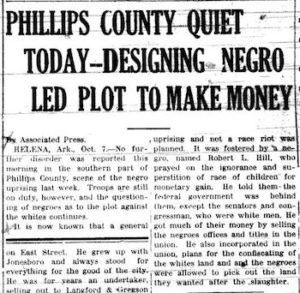
News Headline (1919)
*On this date in 1919, a Race Riot broke out in Elaine, Arkansas, in Phillips County between Blacks and whites.
At the time, many black sharecroppers had not received their share of wages, and they wanted to join the Progressive Farmers and Household Union of America. Also, the early years of the twentieth century were the time of “Red Summers,” violent years after Reconstruction.
The town's white citizens thought the society was trying to persuade the sharecroppers to create violence. That month, union members met near Elaine under armed guards. Two armed white men, one a deputy sheriff and the other a railroad worker, showed up, and a fight developed. Both men were shot, and a railroad worker was killed. Several Black and white citizens of the area were killed for two days. The fighting ended when Arkansas Gov. Charles Brough brought in United States soldiers to contain the violence. At the end of the violence, 65 Blacks were brought to trial.
Twelve were sentenced to death, and the others appealed to higher courts. Scipio Jones, a Black lawyer from Little Rock, helped to fight for justice for the accused at Elaine. He received assistance from the (then) newly formed National Association for the Advancement of Colored People (NAACP). As a result, the rest of the condemned men were set free, and the governor brought Black and white citizens together to discuss problems between the races. No clear-cut answer for the violence was ever found.
Presently, attempts to come to terms with what truly occurred have led to efforts to pay reparations to the victims. No one at this point is leading an effort for reparations in Elaine. Robert Miller, who became the first Black mayor of nearby Helena, grew up hearing the stories because he is related to one of the four Black men who were killed in custody. Because of the riots, his grandmother sent his father to Boston to attend school. Currently, race relations in the county are particularly strained.
The West Helena mayor's office and City Council are divided along racial lines, as is the county Quorum Court. An Oklahoma state commission recommended reparations for Black survivors of a 1921 rampage by white mobs in Tulsa. Historians say as many as 300 blacks were killed. In 1994, Florida approved $2 million in compensation for nine survivors and dozens of descendants of a 1923 attack on Blacks in Rosewood, Fla.
Anatomy of Four Race Riots,
Lee E. Williams and Lee E. Williams II,
The University and College Press of Mississippi, 1972